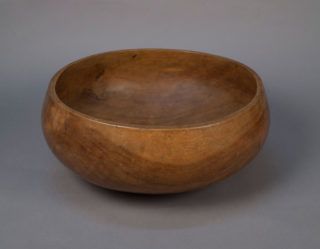Hawaiian Poi Bowls
 The Polynesian archipelago of Hawaii is renowned for its finely carved wooden bowls, platters, and trays. While most were used for eating, some larger examples served as storage.
The Polynesian archipelago of Hawaii is renowned for its finely carved wooden bowls, platters, and trays. While most were used for eating, some larger examples served as storage.
Carvers preferred the wood of the koa (or kou) tree because its grain was relatively soft and easy to cut. Food bowls were carefully carved from hardwoods with stone and later metal tools; some were also hollowed out with fire. Next, the bitterness in the wood was removed by soaking in sea water; the wood was further sweetened by an application of fermented taro or sweet potato. Finally, the bowl was polished with pumice or shark skin, and rubbed to a high gloss with nut oil. This coating helped waterproof the wood, extending its life.
Most of the round wooden bowls were used for serving poi, the traditional Hawaiian staple food. Poi is made from taro root that has been steamed or boiled. Pounded to a paste, it is served in a fairly liquid state, often slightly fermented.
Most people ate their poi from gourd bowls and cups, and it is clear that wooden poi bowls–more often used by chiefs–were modeled on these gourd containers. Poi bowls were stabilized by a thicker bottom, and some had gourd covers. Larger examples, used for feasts, were transported with fiber nets. To repair a damaged bowl was a mark of respect. Cracks were sewn with fine cordage and holes were filled with custom-made wooden pegs. Any imperfections were filled with a breadfruit-gum compound and smoothed away with pumice.
In addition to serving poi, wooden bowls were used for storing poi, salting and serving meat (pork, dog, and large fish), and storing tapa cloth and feathers. Other forms included elongated trays and platters, dishes, plates, cups, finger bowls, and bowls for food scraps. In addition to these plain food and storage bowls, Hawaiians made more elaborate figurative bowls for chiefs and royalty.
The Museum has almost thirty wooden poi bowls and related platters. About half of them were collected by Jackson R. Myers, who acquired them, along with other items, in Hawaii between 1900 and 1905. Little is known about him, but he seems to have worked as a manager on a sugar plantation in Kilauea, Kauai.
In 1908 Phoebe Hearst donated the poi bowl illustrated here; seven Hawaiian bowls were included in two South Seas accessions. These items strengthened the museum’s regional holdings from Oceania, dating back to the earliest University collections in 1873. For a museum located in a coastal community with strong ties to Hawaii, Mrs. Hearst thought it important to represent Pacific cultures with these fine examples of the woodworker’s art.
